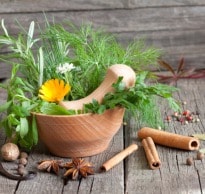Nature At Your Service: Discover the Best Indian Herbs
 It's common knowledge that everything green falls under the umbrella of healthy. Our parents and grandparents have harped on it for many years and we ourselves have slowly but gradually discovered the numerous benefits of eating green and organic food.
It's common knowledge that everything green falls under the umbrella of healthy. Our parents and grandparents have harped on it for many years and we ourselves have slowly but gradually discovered the numerous benefits of eating green and organic food.Enter herbs. They're green, delicious and brimming with fiber, vitamins and minerals. And because of drastic lifestyle changes we've come to depend more on them than ever before. These green leafy geniuses help to ward off heart disease, diabetes, obesity and a lot of other health problems.
We know they work as brilliant kitchen ingredients, have healing powers and are absolutely essential for our mind, body and soul.
Dry or Fresh?
We eat some green herbs like kadi patta, parsley, mint and basil in their raw form and a few others like thyme, oregano and rosemary in their dry form. While herbs in their dry form might serve their purpose as garnish they have very little nutrition value.
This World Environment Day 2014 we give you a lowdown on the healthiest herbs and why you should use them.
Curry Leaves
Kadi patta or curry leaves are perhaps one of the most popular herbs used in India and also grown in our backyard. As the name suggests, curry leaves are added to curries, soups, chutney and also used to season all types of meat and seafood.
Why is it healthy?
They're a rich source of iron and folic acid, antioxidants and also have antibacterial properties. They lower cholesterol, provide protection from heart disease, strengthen the stomach, help with digestion, provide protection from liver damage, reduce congestion in the chest and nose, reduce hair fall and beat early ageing.
Coriander
Dhaniya, cilantro or coriander is commonly used as a condiment or garnish and gives your food a warm, aromatic and citrusy flavour.
Why is it healthy?
It has eleven components of essential oils, six types of acids, minerals and vitamins. It helps lower cholesterol levels, reduce skin inflammation, lower blood pressure, ward off mouth ulcers and also works as an anti-allergic. Coriander is a rich source of calcium that helps strengthen bones and prevents bone degradation.
Fenugreek
Methi or fenugreek is a widely used herb with a bitter taste and strong aroma.
Why is it healthy?
Methi contains protein, fiber, vitamin C and K, niacin, potassium, iron and alkaloids. It's considered very good for diabetic patients, reduces the risk of heart disease, aids digestion, helps maintain a hormonal balance for women, cures acid reflux or heartburn and also helps to prevent colon cancer.
Mint Leaves
One of the oldest and most popular herbs, mint leaves are used in soup, rice, curries and even desserts.
Why is it healthy?
Mint has the highest levels of antioxidants amongst all food which helps in digestion. Drinking mint tea cleanses the stomach and helps with irritated bowel syndrome. It acts as a cooling ingredient for the skin and helps deal with skin irritation. It helps with teeth whitening, fights bad breath and is an excellent blood cleanser.
Ashwagandha
Ashwagandha, also known as the Indian Ginseng is one of the most powerful medicinal herbs. It is more than 3000 years old and has extensively been used in Ayurveda.
Why is it healthy?
It is helpful in treating anxiety, lowering inflammation and blood pressure, balancing the nervous system and strengthening the immune system.
Basil
This type of basil is different from Tulsi or the Holy Basil. It is a popular culinary herb used world over for its aroma and flavor. It has a strong, pungent and sweet smell. And is most commonly used as the hero ingredient in pesto.
Why is it healthy?
Basil has medicinal properties that work on certain diseases and ailments. It is used as an essential oil in aromatherapy. It also reduce inflammation and swelling and can help prevent the harmful effects of ageing.
No comments:
Post a Comment